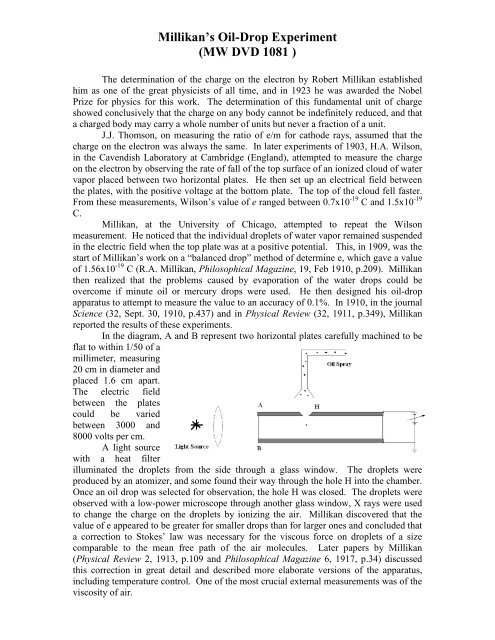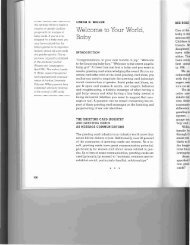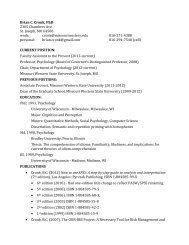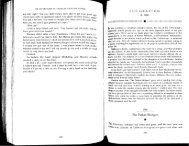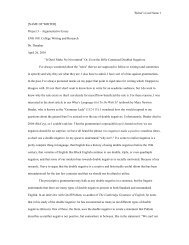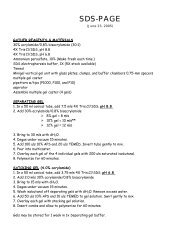Millikan Oil Drop
Millikan Oil Drop
Millikan Oil Drop
You also want an ePaper? Increase the reach of your titles
YUMPU automatically turns print PDFs into web optimized ePapers that Google loves.
<strong>Millikan</strong>’s <strong>Oil</strong>-<strong>Drop</strong> Experiment<br />
(MW DVD 1081 )<br />
The determination of the charge on the electron by Robert <strong>Millikan</strong> established<br />
him as one of the great physicists of all time, and in 1923 he was awarded the Nobel<br />
Prize for physics for this work. The determination of this fundamental unit of charge<br />
showed conclusively that the charge on any body cannot be indefinitely reduced, and that<br />
a charged body may carry a whole number of units but never a fraction of a unit.<br />
J.J. Thomson, on measuring the ratio of e/m for cathode rays, assumed that the<br />
charge on the electron was always the same. In later experiments of 1903, H.A. Wilson,<br />
in the Cavendish Laboratory at Cambridge (England), attempted to measure the charge<br />
on the electron by observing the rate of fall of the top surface of an ionized cloud of water<br />
vapor placed between two horizontal plates. He then set up an electrical field between<br />
the plates, with the positive voltage at the bottom plate. The top of the cloud fell faster.<br />
From these measurements, Wilson’s value of e ranged between 0.7x10 -19 C and 1.5x10 -19<br />
C.<br />
<strong>Millikan</strong>, at the University of Chicago, attempted to repeat the Wilson<br />
measurement. He noticed that the individual droplets of water vapor remained suspended<br />
in the electric field when the top plate was at a positive potential. This, in 1909, was the<br />
start of <strong>Millikan</strong>’s work on a “balanced drop” method of determine e, which gave a value<br />
of 1.56x10 -19 C (R.A. <strong>Millikan</strong>, Philosophical Magazine, 19, Feb 1910, p.209). <strong>Millikan</strong><br />
then realized that the problems caused by evaporation of the water drops could be<br />
overcome if minute oil or mercury drops were used. He then designed his oil-drop<br />
apparatus to attempt to measure the value to an accuracy of 0.1%. In 1910, in the journal<br />
Science (32, Sept. 30, 1910, p.437) and in Physical Review (32, 1911, p.349), <strong>Millikan</strong><br />
reported the results of these experiments.<br />
In the diagram, A and B represent two horizontal plates carefully machined to be<br />
flat to within 1/50 of a<br />
millimeter, measuring<br />
20 cm in diameter and<br />
placed 1.6 cm apart.<br />
The electric field<br />
between the plates<br />
could be varied<br />
between 3000 and<br />
8000 volts per cm.<br />
A light source<br />
with a heat filter<br />
illuminated the droplets from the side through a glass window. The droplets were<br />
produced by an atomizer, and some found their way through the hole H into the chamber.<br />
Once an oil drop was selected for observation, the hole H was closed. The droplets were<br />
observed with a low-power microscope through another glass window, X rays were used<br />
to change the charge on the droplets by ionizing the air. <strong>Millikan</strong> discovered that the<br />
value of e appeared to be greater for smaller drops than for larger ones and concluded that<br />
a correction to Stokes’ law was necessary for the viscous force on droplets of a size<br />
comparable to the mean free path of the air molecules. Later papers by <strong>Millikan</strong><br />
(Physical Review 2, 1913, p.109 and Philosophical Magazine 6, 1917, p.34) discussed<br />
this correction in great detail and described more elaborate versions of the apparatus,<br />
including temperature control. One of the most crucial external measurements was of the<br />
viscosity of air.
In our experiments, a modified version of <strong>Millikan</strong>’s apparatus is used. An<br />
atomizer produces a large number of oil droplets between the plates. By selective<br />
application of an electric field, one droplet is singled out for observation. The droplets<br />
are contained in a glass-walled compartment, with horizontal plates only about 3 mm<br />
apart and applied voltages in the 100 to 350-volt range. Fields lower than <strong>Millikan</strong>’s are<br />
used since the droplets are also smaller than his. The droplets are observed with a highpower<br />
microscope and a high-sensitivity closed-circuit television system.<br />
Theory:<br />
(I) Measurement of the mass and radius of the droplet.<br />
Consider a spherical drop of density ρ and radius a falling under gravity in air of<br />
density σ. Stokes’ law states that for a spherical body falling with velocity v in a<br />
medium of viscosity η, the viscous resistive force is given by 6πηav. The<br />
Archimedean upward force on the body will be 4πa 3 σg/3. If the falling body has<br />
reached its terminal velocity v and is therefore no longer accelerating, then the<br />
weight of the body must equal the upward force plus the viscous force.<br />
Therefore,<br />
3 3<br />
4πa ρg 4πa σg<br />
= 6πηav<br />
+<br />
3 3<br />
weight viscous upward force<br />
of drop force due to air<br />
4 3<br />
and ( ) 6<br />
3 π a ρ − σ g = πηav<br />
.<br />
Typically, σ is close to ρ/1000 and therefore, within the accuracy of this<br />
4 3<br />
experiment, can be ignored. Then 6<br />
3 π a ρ g = πηav<br />
and 9η<br />
v<br />
a = .<br />
2ρ<br />
g<br />
(II) Static Experiment<br />
If an electric field E is now applied so that the drop, if charged, remains<br />
suspended between the two plates, then the weight of the drop will be balanced by<br />
the upward electric force. Thus if e’ is the total charge on the drop, then<br />
eV '<br />
mg = e'<br />
E = s<br />
where V s is the voltage across the plates and d is the plate<br />
d<br />
mgd ⎛4<br />
3 ⎞ d<br />
separation, and e'<br />
= , or e'<br />
= ⎜ πa ρ ⎟ g . Substituting in our equation above<br />
V<br />
⎝ ⎠ V<br />
to eliminate a we get<br />
s<br />
3<br />
s<br />
1/2<br />
⎧⎪<br />
⎛ 9η<br />
⎞ ⎫⎪v<br />
Kv<br />
e' = ⎨6πµ<br />
d⎜<br />
⎟ ⎬ =<br />
⎪⎩<br />
⎝ ρ g ⎠ ⎪⎭<br />
V V<br />
3/2 3/2<br />
2<br />
s s<br />
where K is the constant within the brackets.<br />
(III) Dynamic Experiment<br />
If the applied voltage is increased above V s , the droplet will rise in this applied<br />
field. If V is now the applied voltage, and the droplet has reached its terminal<br />
velocity, then<br />
3 3<br />
4 π a ρ g eV ' 4 a g<br />
+ 6πηav2<br />
= +<br />
π σ<br />
3 d 3<br />
weight viscous electric upward force<br />
of drop force field force due to air<br />
Solving this for e’, as for the static case, gives the equation:<br />
,
1/2<br />
Kv (<br />
1+<br />
v2)<br />
v1<br />
e'<br />
= , where v 1 is the terminal velocity when falling, and v 2 is the<br />
V<br />
terminal velocity when rising. K is the same constant as for the static case.<br />
(IV) Stokes’ Law Corrections<br />
As a result of the oil-drop experiment, <strong>Millikan</strong> investigated the deviation from<br />
Stokes’ law for small droplets comparable in size to the mean free path of air<br />
molecules. The terminal velocity under these conditions is higher than that given<br />
by Stokes’ law and a Stokes-Cunningham correction is applied.<br />
Since the mean free path of air molecules is related to the atmospheric pressure,<br />
the corrected viscous force can be written as<br />
Method:<br />
⎛ b ⎞<br />
viscous force = 6πηav⎜1 + ⎟ .<br />
⎝ pa ⎠<br />
In <strong>Millikan</strong>’s original paper, b was equal to 6.18x10 -4 where p, the<br />
atmospheric pressure, is measured in cm of mercury and a in cm.<br />
This correction produces a modification to the equations for e’, requiring<br />
3/2<br />
⎛ b ⎞<br />
them to be multiplied by the factor ⎜1+<br />
⎟ .<br />
⎝ pa ⎠<br />
For the experimental conditions and radius of droplets shown in the<br />
program, this factor is 0.83 on average, and the values of e’ should all be<br />
multiplied by 0.85. Exact values, if required, can be found using the Stokes-<br />
Cunningham correction given above in each case.<br />
(1) Free fall under gravity<br />
The velocity v 1 of a drop falling under gravity is found by measuring the<br />
time t g for it to fall through a distance of 3.x10 -4 m after reaching its terminal<br />
velocity. This measurement is repeated several times for the same drop to<br />
average out the effects of Brownian motion. The scale shown on the television<br />
monitor has been previously calibrated with the use of a gradicule placed in front<br />
of the microscope. Each division corresponds to 0.1 mm.<br />
(2) Static Experiment<br />
The voltage V s applied to the plates is adjusted so that the drop remains<br />
stationary in the field if view, V s is then measured. Now, using the values listed<br />
below for K and t g (to calculate v 1 ) and substituting for K, V s , and v 1 in the static<br />
equation will give the value of e’.<br />
Results<br />
(3) Dynamic Experiment<br />
The velocity v 2 is found by measuring the time t f for the oil drop to rise through a<br />
distance of 3x10 -4 m under a measured voltage V. Using the listed values of t g<br />
and t f (to calculate v 1 and v 2 ) together with K and V, the value of e’ can be found<br />
from the dynamic equation.<br />
−1<br />
Parameters used in the experiment<br />
Separation between plates (d)<br />
= 3.3x10 -3 m
Timed distance = 3.0x10 -4 m<br />
Viscosity of air = 1.82x10 -5 Ns/m 2 at 20°C<br />
Density of air = 1.29 kg/m 3<br />
Density of oil = 9.67x10 2 kg/m 3<br />
Atmospheric Pressure of air = 76.1 cm Hg<br />
Gravitational Acceleration (g) = 9.81 m/s 2<br />
Calculate value of K<br />
= 1.05x10 -10 SI Units<br />
Ancillary Data<br />
Plate separation measurement<br />
Mass of S.G. Bottle<br />
Mass of S.G. Bottle & Water<br />
Mass of S.G. Bottle & <strong>Oil</strong><br />
Static experiment<br />
<strong>Drop</strong> # t g (avg) V s<br />
1-5 In film In film<br />
6 10.05 s 82 V<br />
7 3.48 s 150 V<br />
8 2.35 s 170 V<br />
9 5.24 s 111 V<br />
10 8.99 s 53 V<br />
1 st reading: 122.07 mm<br />
2 nd reading: 118.77 mm<br />
17.396 g<br />
41.572 g<br />
40.776 g<br />
Dynamic Experiments<br />
<strong>Drop</strong> # t g (avg) t f (avg) V<br />
1-4 In film In film in film<br />
5 2.78 s 32.00 s 324 V<br />
6 10.05 s 9.10 s 178 V<br />
7 3.48 s 7.23 s 222 V<br />
8 2.35 s 6.91 s 233 V<br />
9 5.24 s 9.75 s 180 V<br />
10 5.27 s 15.10 s 330 V<br />
Conclusions<br />
The calculated values of e’, even without Stokes’ law correction, will show that, if<br />
the average lowest values of e’ are divided into the significantly larger values, the larger<br />
values will be approximately simple multiples of the lowest value. Therefore, the<br />
average lowest value corresponds to the fundamental unit charge e. The accurate value<br />
for e within the experimental errors can be found by applying the Stokes’ law correction<br />
to the results.<br />
Student Activities: Student should be prepared to note for themselves the readings for the<br />
first 5 static experiments and the first 4 dynamic experiments. A stopwatch will be<br />
necessary.


